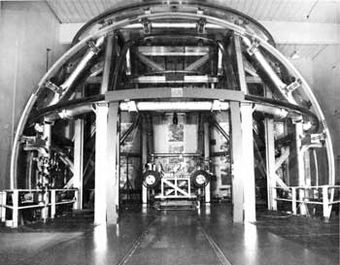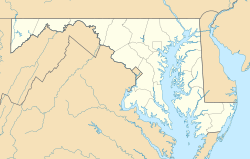Spacecraft Magnetic Test Facility facts for kids
|
Spacecraft Magnetic Test Facility
|
|
 |
|
| Location | Good Luck Road, Greenbelt, Maryland |
|---|---|
| Built | 1966 |
| Architect | NASA |
| NRHP reference No. | 85002811 |
Quick facts for kids Significant dates |
|
| Added to NRHP | October 3, 1985 |
| Designated NHL | October 3, 1985 |
The Spacecraft Magnetic Test Facility is a special place at the Goddard Space Flight Center in Greenbelt, Maryland, United States. It's also known as the Attitude Control Test Facility. This building was made in 1966 to help scientists test how magnets affect spacecraft. It also helps them make sure special tools called magnetometers are super accurate.
This building is unique because it's built from materials that aren't magnetic. It even has a special system that can cancel out the Earth's magnetic field. This helps create a perfect environment for testing. Because it's so important, it was named a National Historic Landmark in 1985. The Goddard Mechanical Systems Division currently manages this facility.
Contents
What is the Spacecraft Magnetic Test Facility?
The Spacecraft Magnetic Test Facility is located about 2 kilometers (1.2 miles) east of the main Goddard Space Flight Center. You can find it in Building 310-20 on Good Luck Road. The building is a single story and measures 60 feet (18 meters) square. It's built completely from materials that don't have magnetic properties.
How does the facility work?
Inside, there's a large, 42-foot (13-meter) wide coil system called a Braunbek coil. This system has four loops on each side. It works to cancel out the Earth's magnetic field in a central area. This central area is like a bubble, about 6 feet (1.8 meters) wide.
The facility can make the magnetic field inside super stable. It can even create its own magnetic fields and spin them around. This helps scientists test how spacecraft react in different magnetic conditions. There's also a large hoist that can lift heavy equipment. The building has special air filters and air conditioning too. A turntable inside helps place the test objects perfectly.
Why is this facility important for space?
This special building was built in 1966. Since then, it has been used to check and reduce the magnetic effects on unmanned spacecraft. It also helps make sure the magnetometers used in space are very precise. Magnetometers are tools that measure magnetic fields.
What can the facility do?
The facility can create magnetic conditions similar to those found in space. This includes conditions in orbit around Earth or even far out in interstellar space. It was used a lot until the 1990s. The instruments here can also map out the magnetic features of the objects being tested. Over the years, some parts of the facility have been updated to keep it working well.
Images for kids




